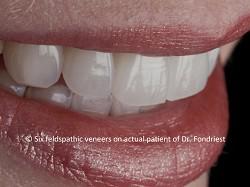Modern dental implant treatment has been used for more than 25 years. In the last 10 years, it has become increasingly popular and more affordable. Dental implants are a high quality, durable, and esthetically pleasing treatment to replace missing teeth or to secure a denture, partial, or bridge.
Many people suffer from tooth loss because of extensive dental decay, periodontitis (advanced gum disease), or trauma. An estimated 25% of Americans over age 65 have lost all of their teeth, according to the CDC. Tooth loss contributes to poor diet, low self-esteem, and an inability to speak clearly. Fortunately, people do not have to live without teeth. Whether you’re missing one tooth or all of your teeth, Dr. Fondriest offers practical, long-term solutions sure to make you smile.
Dental implants provide the patient with a fully functioning and natural looking dental prosthetic, without relying on the gums or surrounding teeth for support. Partials and bridges do rely on adjacent teeth. Bridges feature crowns, secured to healthy teeth, to hold the prosthetic in place. Partials have clasps that attach to neighboring teeth. Placing more weight and work on healthy teeth can lead to more dental damage in the long run. Dentures are made to rest on the contours, or ridges, of the gums. Over time, the natural ridges wear down and dentures become more prone to slippage, looseness, and poor fit.
At Lake Forest Dental Arts, we want to preserve your smile and restore your confidence, while using the marvels of modern dental technology and science. Dr. Fondriest provides many options for dental implants, and based on your case, he’ll recommend the optimal choice. With proper care, your dental implants can last a lifetime.
To find out if how dental implants can change your life, schedule your consultation with Dr. James Fondriest today. Call 847-234-0517. Lake Forest Dental Arts serves patients of North Chicago and surrounding areas.


 out of
out of 




